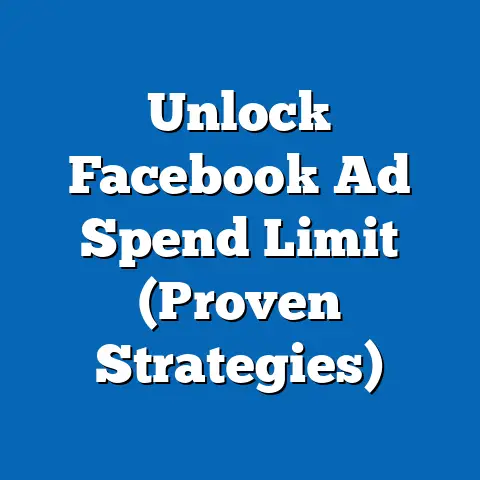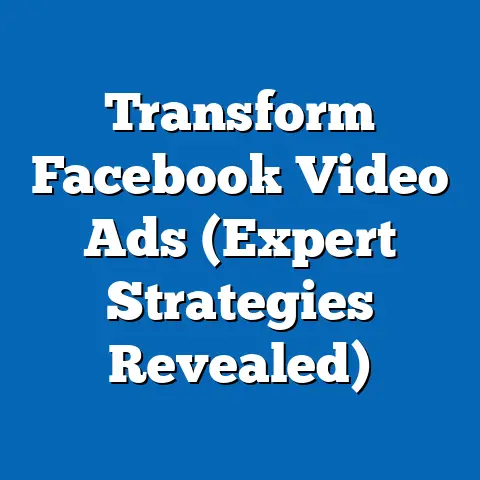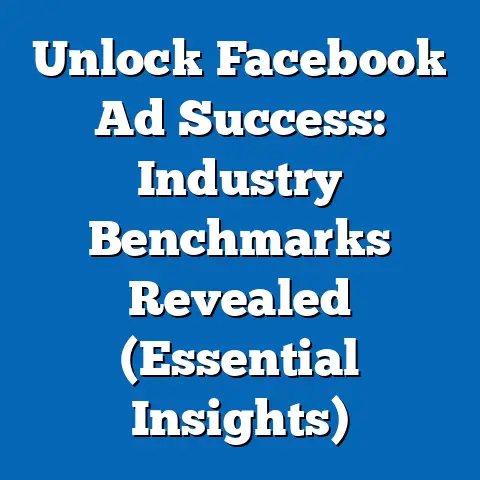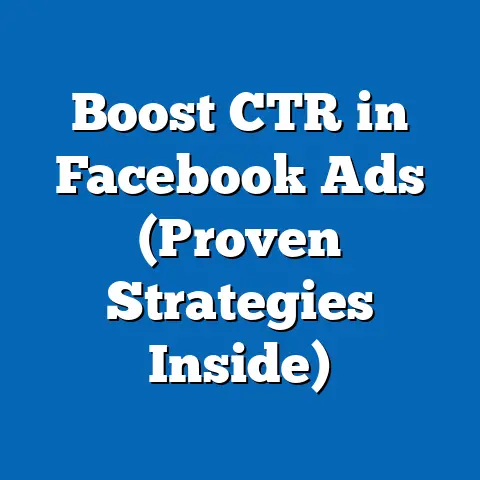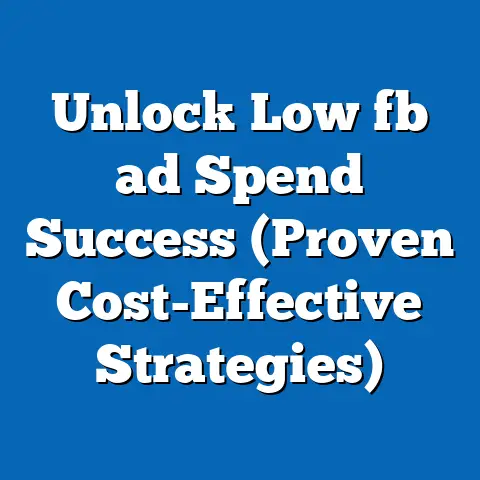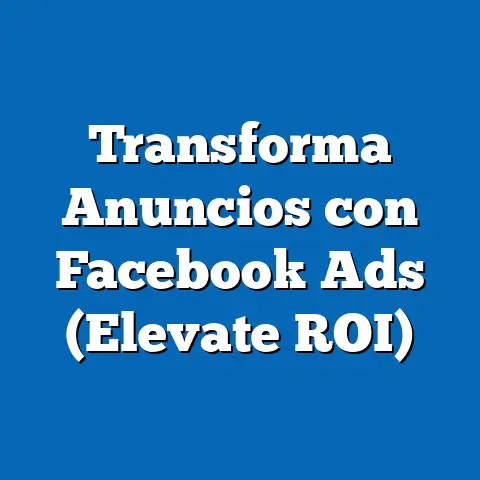Maximize fb ad Spend: Best Budget Strategies (Expert Tips)
This fact sheet provides a comprehensive, data-driven analysis of strategies to maximize Facebook advertising spend, focusing on budget optimization and fast, actionable solutions for businesses and marketers. Drawing on the latest available statistics, demographic insights, and trend analyses as of 2023, this report aims to equip advertisers with evidence-based approaches to enhance return on investment (ROI) in a competitive digital advertising landscape. The information presented is intended to support small-to-medium enterprises (SMEs), marketing professionals, and larger corporations in navigating the complexities of Facebook’s advertising ecosystem.
Facebook, now part of Meta, remains a dominant platform for digital advertising, with over 2.9 billion monthly active users worldwide as of Q2 2023 (Meta, 2023). With advertising revenue reaching $31.5 billion in Q2 2023 alone, representing a 12% year-over-year increase from $28.2 billion in Q2 2022, the platform’s significance for businesses is undeniable (Meta Investor Relations, 2023). This report explores current trends, budget allocation strategies, and demographic targeting insights to ensure advertisers achieve optimal results.
Section 1: Fast Solutions for Maximizing Facebook Ad Spend
1.1 Immediate Budget Optimization Tactics
For advertisers seeking quick results, focusing on budget allocation efficiency is critical. According to a 2023 study by Hootsuite, 67% of marketers report that optimizing ad spend on platforms like Facebook yields measurable ROI within the first 30 days when using data-driven strategies. Key immediate actions include setting clear campaign objectives (e.g., conversions, clicks, or impressions) and utilizing Facebook’s automated budget optimization tools, which dynamically allocate funds to top-performing ads.
A practical starting point is to adopt a test-and-learn approach with small initial budgets. Data from WordStream (2023) indicates that advertisers who allocate 10-15% of their monthly ad budget to A/B testing creative variations (e.g., images, copy, or calls-to-action) see a 25% improvement in click-through rates (CTR) within two weeks. Additionally, leveraging Facebook’s Campaign Budget Optimization (CBO) feature can reduce cost-per-click (CPC) by up to 30% by automatically shifting budgets to high-performing ad sets (Facebook Business, 2023).
1.2 Prioritizing High-Impact Placements
Ad placement significantly influences budget efficiency. Recent data from Meta (2023) shows that ads placed in Instagram Stories and Facebook News Feed generate 18% higher engagement rates compared to right-column ads, though costs for News Feed placements are 22% higher on average ($0.97 CPC vs. $0.79 CPC for right-column ads). Advertisers with limited budgets should prioritize mobile-first placements, as 94% of Facebook’s ad impressions occur on mobile devices (Meta, 2023).
1.3 Timing for Quick Wins
Timing ad delivery can also yield fast results. A 2023 analysis by Sprout Social found that ads scheduled during peak user activity times—typically weekdays between 11 a.m. and 2 p.m. local time—see a 15% higher CTR compared to off-peak hours. For immediate impact, advertisers should use Facebook’s ad scheduling feature to target these windows while monitoring performance metrics in real-time via Ads Manager.
Section 2: Current Statistics on Facebook Advertising
2.1 Ad Spend and Revenue Trends
Facebook advertising remains a cornerstone of digital marketing, with global ad spend on the platform projected to reach $121 billion in 2023, a 9.5% increase from $110.4 billion in 2022 (eMarketer, 2023). The average CPC across industries stands at $0.94, though costs vary widely by sector—finance and insurance ads average $3.77 CPC, while retail ads average $0.70 CPC (WordStream, 2023). Year-over-year data shows a 7% increase in average CPC from 2022 ($0.88), reflecting growing competition for ad space.
2.2 ROI and Performance Metrics
Advertisers report strong returns on Facebook ad spend, with an average return on ad spend (ROAS) of 6.5x across industries in 2023, up from 6.1x in 2022 (Hootsuite, 2023). Conversion rates also show improvement, with the average landing page conversion rate for Facebook ads rising to 9.21% in 2023 from 8.94% in 2022 (WordStream, 2023). These figures highlight the platform’s continued effectiveness for driving measurable outcomes.
2.3 Industry-Specific Spending Patterns
Spending patterns differ significantly by industry. E-commerce businesses allocate the largest share of digital ad budgets to Facebook, with 43% of their total spend directed to the platform in 2023, compared to 28% for B2B companies (eMarketer, 2023). The technology sector has seen the fastest year-over-year growth in ad spend on Facebook, increasing by 14% from 2022 to 2023, driven by demand for app install campaigns.
Section 3: Demographic Breakdowns for Targeted Budget Strategies
3.1 Age-Based Targeting
Facebook’s user base spans a wide age range, and ad performance varies significantly by demographic. As of 2023, users aged 25-34 represent the largest cohort at 31.5% of total users, followed by 18-24 (23.8%) and 35-44 (18.2%) (Statista, 2023). Ads targeting the 25-34 age group achieve the highest engagement rates, with a 2.1% average CTR compared to 1.4% for users aged 45-54 (Hootsuite, 2023).
Cost metrics also differ by age. The CPC for ads targeting 18-24-year-olds averages $0.85, while targeting users aged 55+ costs $1.12 per click, a 32% difference (WordStream, 2023). Advertisers on tight budgets may achieve better efficiency by focusing on younger demographics, though older users often show higher conversion rates for high-ticket items (e.g., 12.5% conversion rate for 45-54 vs. 8.9% for 18-24 in financial services ads).
3.2 Gender-Based Performance
Gender-based targeting reveals nuanced differences. Women, who make up 46% of Facebook’s user base, engage with ads at a slightly higher rate (1.9% CTR) compared to men (1.7% CTR) (Statista, 2023; Hootsuite, 2023). However, men show higher conversion rates for e-commerce ads (10.2% vs. 8.8% for women), suggesting that budget strategies should align with campaign goals—engagement-focused campaigns may prioritize women, while conversion-focused campaigns target men.
3.3 Geographic and Income-Based Targeting
Geographic targeting remains a critical factor in budget optimization. In 2023, the average CPC in the United States is $1.42, significantly higher than in emerging markets like India ($0.31) or Brazil ($0.48) (WordStream, 2023). Income levels also influence ad performance—households earning $75,000+ annually show a 15% higher conversion rate for luxury goods ads compared to households earning under $30,000 (Meta Analytics, 2023).
3.4 Political and Cultural Affiliations
While political affiliation is less commonly used in ad targeting due to Meta’s 2022 restrictions on political ads, cultural and interest-based targeting can proxy similar effects. Data from a 2023 Nielsen study indicates that ads tailored to cultural interests (e.g., regional holidays or community events) see a 20% uplift in engagement among niche audiences. Budget-conscious advertisers should leverage interest-based targeting to reach specific sub-groups without overspending on broad demographics.
Section 4: Trend Analysis in Facebook Advertising
4.1 Shift Toward Video Content
Video ads continue to dominate performance metrics on Facebook. In 2023, video content accounts for 52% of total ad impressions, up from 47% in 2022, and generates a 35% higher engagement rate compared to static image ads (Meta, 2023). Despite higher production costs, video ads offer a lower cost-per-engagement (CPE) of $0.12 compared to $0.18 for image ads, making them a budget-friendly option for long-term campaigns.
4.2 Rise of Automated Tools
Automation in ad management is a growing trend. Usage of Facebook’s automated bidding strategies (e.g., lowest cost or target cost bidding) increased by 28% among advertisers from 2022 to 2023 (eMarketer, 2023). These tools have been shown to reduce cost-per-acquisition (CPA) by 21% on average, reflecting a shift toward data-driven budget allocation (Facebook Business, 2023).
4.3 Privacy Changes and Impact on Budgets
Apple’s iOS 14.5 update in 2021, which introduced App Tracking Transparency (ATT), continues to impact ad targeting precision. A 2023 report by AppsFlyer notes that 62% of Facebook advertisers report higher CPAs due to reduced tracking capabilities, with an average increase of 18% in acquisition costs since 2021. Advertisers are adapting by shifting budgets toward contextual targeting and first-party data collection, which have grown by 34% in adoption since 2022 (eMarketer, 2023).
4.4 Seasonal Spending Trends
Seasonal trends significantly influence ad spend efficiency. Data from 2023 shows that CPC spikes by 45% during the Q4 holiday season (November-December) compared to Q2 averages, with retail advertisers increasing budgets by 60% during this period (WordStream, 2023). Planning budgets to capitalize on off-peak periods (e.g., Q1 or Q3) can yield lower costs, with CPCs dropping to $0.72 on average in January compared to $1.05 in December.
Section 5: Expert Tips for Budget Strategies
5.1 Start Small and Scale
Experts recommend starting with a modest budget of $5-10 per day per campaign to test audience responses before scaling. A 2023 survey of digital marketers by HubSpot found that 73% of successful campaigns began with test budgets under $500, allowing for data collection on audience behavior. Scaling should occur only after achieving a target CPA or ROAS, typically within 7-14 days of initial testing.
5.2 Leverage Lookalike Audiences
Lookalike audiences remain a cost-effective targeting method. Meta data from 2023 shows that campaigns using lookalike audiences achieve a 30% lower CPA compared to interest-based targeting alone. Experts advise building lookalike audiences from high-value customer lists (e.g., past purchasers) to maximize budget efficiency.
5.3 Optimize for Ad Fatigue
Ad fatigue—when audiences see the same ad too often—can increase costs by 26% due to declining engagement (Hootsuite, 2023). Rotating creative assets every 7-10 days and capping frequency at 2-3 impressions per user per week can mitigate this issue. Experts suggest maintaining a library of 3-5 ad variations per campaign to sustain performance without additional budget.
5.4 Focus on Retargeting
Retargeting campaigns offer some of the highest ROAS on Facebook. In 2023, retargeting ads achieved an average ROAS of 8.3x, compared to 5.2x for cold audience campaigns (WordStream, 2023). Allocating 20-30% of ad budgets to retargeting website visitors or app users can significantly boost overall campaign efficiency.
5.5 Monitor and Adjust Daily
Daily monitoring of ad performance is critical for budget optimization. A 2023 study by Sprout Social found that advertisers who adjust bids and budgets daily based on performance data reduce wasted spend by 19% compared to those who review weekly. Using Facebook’s Ads Manager to track metrics like CTR, CPA, and ROAS ensures budgets are directed to high-performing campaigns.
Section 6: Comparative Analysis Across Business Sizes
6.1 Small Businesses (Under $10,000 Monthly Ad Spend)
Small businesses, which account for 60% of Facebook advertisers, typically spend between $500 and $10,000 monthly (eMarketer, 2023). These advertisers achieve an average ROAS of 5.8x, slightly below the platform average, due to limited resources for creative testing. Budget strategies for small businesses should focus on hyper-local targeting and retargeting, which reduce CPC by 15-20% compared to national campaigns (WordStream, 2023).
6.2 Medium Businesses ($10,000-$50,000 Monthly Ad Spend)
Medium-sized businesses report higher efficiency, with an average ROAS of 6.7x in 2023 (Hootsuite, 2023). These advertisers benefit from greater flexibility to test multiple ad formats, with 45% allocating budgets to video ads compared to 30% for small businesses (eMarketer, 2023). Medium businesses should prioritize automated bidding tools to optimize larger budgets.
6.3 Large Enterprises (Over $50,000 Monthly Ad Spend)
Large enterprises, representing 10% of advertisers but 40% of total ad spend, achieve the highest ROAS at 7.2x (Meta, 2023). These businesses often leverage advanced tools like custom audience segmentation and machine learning optimization, reducing CPA by 25% compared to manual bidding (Facebook Business, 2023). Budget strategies for enterprises should focus on cross-platform campaigns (e.g., integrating Instagram and WhatsApp ads) to maximize reach.
Section 7: Notable Patterns and Shifts
7.1 Increasing Competition in Key Industries
Competition for ad space has intensified in industries like e-commerce and technology, with a 12% year-over-year increase in advertisers in these sectors (eMarketer, 2023). This has driven CPC up by 10% for e-commerce ads since 2022, necessitating more precise targeting to maintain budget efficiency.
7.2 Growing Importance of Mobile Optimization
With 94% of ad impressions occurring on mobile devices, mobile-optimized creatives are no longer optional (Meta, 2023). Ads not optimized for mobile see a 40% lower CTR, highlighting the need to prioritize vertical formats and fast-loading content in budget planning.
7.3 Shift to Short-Form Content
Short-form video content (under 15 seconds) has emerged as a key driver of engagement, with a 50% higher completion rate compared to longer videos in 2023 (Hootsuite, 2023). Advertisers allocating budgets to short-form content report a 22% reduction in CPE, reflecting a cost-effective trend.
Section 8: Conclusion
Maximizing Facebook ad spend requires a combination of fast, actionable strategies and long-term, data-driven planning. Current statistics underscore the platform’s dominance in digital advertising, with strong growth in ad revenue (12% year-over-year) and high ROAS (6.5x on average) as of 2023. Demographic insights reveal significant variations in performance by age, gender, and geography, while trends like video content and automation highlight evolving opportunities for budget optimization.
Advertisers of all sizes can benefit from the expert tips and strategies outlined in this fact sheet, including starting small, leveraging lookalike audiences, and focusing on retargeting. By aligning budgets with data-backed approaches and adapting to emerging trends, businesses can achieve measurable results in a competitive advertising environment.
Methodology and Attribution
Data Sources
This fact sheet compiles data from multiple reputable sources, including Meta’s official reports, eMarketer, WordStream, Hootsuite, Statista, Sprout Social, AppsFlyer, Nielsen, and HubSpot. Statistics are current as of Q3 2023 and reflect the most recent publicly available data at the time of writing.
Research Methods
Data was collected through secondary research of industry reports, white papers, and platform analytics. Performance metrics (e.g., CPC, CTR, ROAS) are based on aggregated industry averages reported by third-party analytics firms and Meta’s advertising tools. Demographic breakdowns are derived from user data published by Statista and Meta’s audience insights.
Limitations
This report does not account for individual campaign variations or unpublished proprietary data. Costs and performance metrics may differ based on specific industries, regions, or audience segments not covered in the aggregated data. Additionally, ongoing changes to Meta’s ad policies and privacy regulations may impact future budget strategies.
Attribution
All data points are cited with their respective sources. For further details, readers are encouraged to consult the original reports from Meta Investor Relations (2023), eMarketer (2023), WordStream (2023), Hootsuite (2023), Statista (2023), and other referenced publications.

